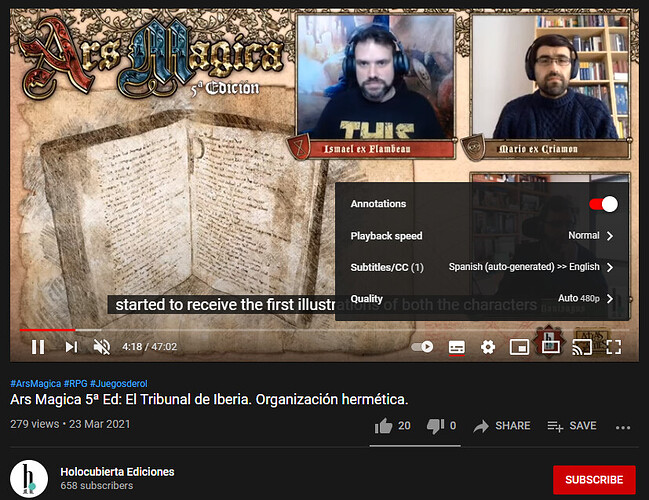And the subtitles work in the YouTube video!
There are typos! And mistakes! And aaaaaaaa.... 

I am the sort of guy that takes more offense to deleted expletives than the natural presence of expletives. So thank you for leaving them in!
Thank you for the translation
Thank Jason for roping me in.
Now I'm binge-reading the core rulebook 
Video Update!
If only I knew what they are saying
Hey!
In case it helps I posted a summary (in english) on my blog. It should (hopefully) cover all the points they went through during the streaming.
Here is the link
Thank you!
Thanks for the summary.
Well, a few days after posting on youtube, auto-generated captions with auto-translation become available.
To display subtitles in English, first click on the rectangular icon to the left of the cogwheel. This activates the auto-generated closed captions in Spanish. Then click on the cogwheel (settings) and select subtitles -> auto-translate which brings up a pull-down menu of available languages. Google translate not always produces the best results, even less so working off captions auto-generated by speech recognition. So, if you have any questions about nonsensical text, ask here with the English caption and the video timestamp. Embedded video below.
I have to say the bit about Duresca is a little exaggerated:
Finally, the big bad guys (for some) Duresca are back in force. A center for both the judiciary of the Tribunal and its corruption the authors hinted that the Guernicus Covenant is to play a key role in the power games around the Way of Santiago.
"the big bad guys (for some)" is not in the video but Tadein's own interpretation. Duresca is discussed starting after 37' in the video until about 40'. An important feature of Duresca is that it has a large number of chapter houses mostly associated with pilgrim hospitals along St. James' way. This gives it both Hermetic and mundane influence. Another interesting feature of the new book is that there is a second major Guernicus covenant in Al-Andalus which acts as a counterweight to Duresca in the politics of the Iberian tribunal, by working to watch closely the movements of Duresca.
Salvete, sodales!
A second video update about the new Tribunal of Iberia is now on YouTube https://www.youtube.com/watch?v=3n3F-3spwik
Highlights of the new YouTube:
- the book title will be 'Finis Terræ, the Tribunal of Iberia'
- the video focuses on Ch.3 on Hermetic history (ca. 30k words)
- they show off some art by Loles Romero (eye candy here https://www.artstation.com/lolesromero )
- they outline two Covenants (after about 51' in the video)
On Hermetic history
- the aim of the book is to provide enough information to play in any time period since the founding of the Order of Hermes, so there is comparatively more detail of the 8th to 13th centuries and less of ancient history than in other Tribunal books
- initial expansion of Flambeau into Iberia
- the book outlines every Tribunal meeting and its contributions to the Peripheral Code of Iberia
- there is a special focus on the Tempest Wizards (hedge magicians with powerful weather magic) from the North of the peninsula, including eventually a magical war that wipes them out with a few survivors joining the Order. There are rules for playing a Tempest Wizard
- a second form of Hedge magic are 'vates'. Not much is said about them beside the name [which is Latin for prophet and is used in medieval Spain to describe a bard, too]
- they detail the effect of the major crises of the Order on Iberia, focusing on the Schism War, the Tremere Sundering, and the war with Damhan-Allaidh and the foundation of Ordo Miscellanea
- On Pralix' war they say Iberian covenants take active part in the fight and some, in particular Duresca, side with Ordo Miscellanea when it is founded
- Duresca starts out as a Diedne covenant, then becomes an Ex-Miscellanea covenant, and after the affair with the Scrolls it becomes the Guernicus covenant that it is in 1220
- evolving allegiances and philosophies of individual Covenants is a theme of the book as the population of magi changes through the centuries
- after the Tremere sundering the Tribunal becomes less warlike to the chagrin of the Flambeau and focuses on building a peace, in the process absorbing a lot of Arabic influence [note that in the 9th century Iberia was almost entirely Moorish-dominated]
- another theme of the book is how Arabic cultural influence (as a conduit also for Hellenistic culture) influences the Tribunal and makes it distinct from the rest of the Order
- the Criamon of Iberia have a very strong focus on mundane philosophy too
- during the Schism war one of the Iberian representatives (Apsa or Absa, a moorish woman) strongly objects to the expulsion of the Diedne which leads to a split of the Tribunal with the Southern Moorish half refusing to take part in the war
- the unofficial 'Tribunal of Al-Andalus' continues to impart a peculiar character to its covenants even after the split is resolved
On art by Loles Romero:
- screenshots after 35'25", 42', and 45'30" in the video
Thank you so much for this amazing summary.
It was a lot easier than a transcript
It was also easier to skim through, thanks!
Wow - this could make for a very interesting tribunal book, I look forward to seeing the finished product! And am super hopeful for an English translation!
Aaand... a third video on the new Tribunal of Iberia is up, this time with a sneak peek at the cover art. https://youtube.com/embed/AQTbwGSQ-J4
and, with google lens, you can just read the spanish version, or at least read it well enough to use it...
I mean, I read spanish, so I'll use it to fill in the gaps when I don't understand, but you can use it for most of the text if you can't...


